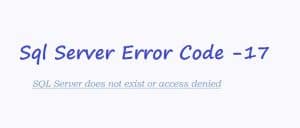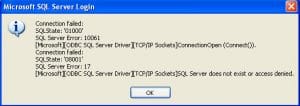In this article we check out the cause behind the SQL Server error code 17
Sometimes while trying to access the SQL Server database, one might come across an error stating
 “SQL Server does not exist or access denied”. This is a general Microsoft Data Access Components (MDAC) message indicating that the computer running Microsoft SQL Server can’t be reached. It is also known as error code 17. This general message has various potential causes. One of them might be that the server actually does not exist on the system or is unavailable; another reason might be that it could not be found. Apart from these obvious reasons there are also various server or client related reasons behind the error code, which are as follows:
“SQL Server does not exist or access denied”. This is a general Microsoft Data Access Components (MDAC) message indicating that the computer running Microsoft SQL Server can’t be reached. It is also known as error code 17. This general message has various potential causes. One of them might be that the server actually does not exist on the system or is unavailable; another reason might be that it could not be found. Apart from these obvious reasons there are also various server or client related reasons behind the error code, which are as follows:
Server- related problems– if none of the client computers can access the SQL server, there is probably a problem in the server itself. It might be either of the following:
- SQL server isn’t installed in the computer specified in the connection string.
- SQL server could not be started.
- SQL Server is not sensing the protocol or computer circuit being used to connect.
- The name of SQL Server is different from the name of the computer.
- For a multi-homed computer running SQL Server 2000 Desktop Engine (MSDE), clients might be unable to connect with the server.
- While attempting to open a connection on a computer running SQL Server 2000 over a virtual private network (VPN) connection, the attempt will most-probably fail.
- For the SQL Server Desktop Engine (also called MSDE 2000) Service Pack 3 (SP3) or SP3a, only local connectivity is allowed, with no other options available.

- The name of the computer does not exist on the SQL server.
- If you are trying to access a named occurrence of SQL Server, be sure to specify the correct occurrence name. Incorrect name will not provide access.
- Windows-level security currently in use for connecting is usually different from what you expect.
- You might be using in-correct protocol.
- If there is a cluster in SQL Server, the network adapters might get configured incorrectly or might have an incorrect name.
- It might just be the side effect of an MDAC mismatch. Try reconfiguring MDAC settings.
Network or domain-related problems– if there is an error message only in computers in a particular domain, or a certain subnet, or behind a firewall, the problem might be either of the following:
- Local security policy user rights assignment for your Windows account restricts access from the network.
- There might be a domain trust problem, one of the computers could be in a work-group and therefore might not have access to the domain.
- Your name resolution might not be working.
- A firewall or the router might not be configured properly or could be configured to block UDP port 1434.
Some SQL errors can indicate towards the health of the database instance
Some SQL error codes can indirectly give you a hint towards the health of the database instance. It is always advisable to get to the root cause of SQL errors and resolve them if feasible. Moreover for securing your data in the event of a SQL crash, install a sql server recovery tool like DataNumen SQL Recovery application in your server machine. Once activated, it can swing into action and recover records from compromised SQL file within minutes. Moreover the tool is equipped to bring out nearly every data type that you have stored in the database file and can even recover indexes.
Author Introduction:
Alan Chen is President & Chairman of DataNumen, Inc., which is the world leader in data recovery technologies, including access recovery and sql recovery software products. For more information visit https://www.datanumen.com/